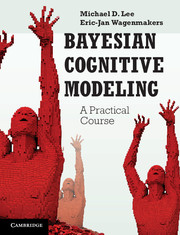Book contents
- Frontmatter
- Contents
- Dedication
- Preface
- Acknowledgements
- Part I Getting started
- Part II Parameter estimation
- Part III Model selection
- Part IV Case studies
- 10 Memory retention
- 11 Signal detection theory
- 12 Psychophysical functions
- 13 Extrasensory perception
- 14 Multinomial processing trees
- 15 The SIMPLE model of memory
- 16 The BART model of risk taking
- 17 The GCM model of categorization
- 18 Heuristic decision-making
- 19 Number concept development
- References
- Index
13 - Extrasensory perception
Published online by Cambridge University Press: 05 June 2014
- Frontmatter
- Contents
- Dedication
- Preface
- Acknowledgements
- Part I Getting started
- Part II Parameter estimation
- Part III Model selection
- Part IV Case studies
- 10 Memory retention
- 11 Signal detection theory
- 12 Psychophysical functions
- 13 Extrasensory perception
- 14 Multinomial processing trees
- 15 The SIMPLE model of memory
- 16 The BART model of risk taking
- 17 The GCM model of categorization
- 18 Heuristic decision-making
- 19 Number concept development
- References
- Index
Summary
More than a hundred years ago, some of the world's most renowned scientists were curious whether or not people can look into the future (precognition), move objects with their mind (telekinesis), or transmit messages by thought (telepathy). These so-called extrasensory abilities were studied by members of the Society for Psychical Research, a society that included intellectual heavyweights such as William James, Carl Jung, and Alfred Wallace. Even as late as 1950, the great Alan Turing argued that his famous test for artificial intelligence should be carried out in a telepathy-proof room.
How times have changed. Scientific work on extrasensory perception, or ESP, is now conducted only by a few self-pronounced academic mavericks, on a Quixotic mission to demonstrate to the world that the phenomenon is real. In 2011, the debate on the existence of ESP was re-ignited when reputable social psychologist Dr Daryl Bem published nine ESP experiments with over 1000 subjects (Bem, 2011). On the basis of these data, Bem argued that people are able to look into the future. In Bem's first experiment, for example, subjects had to guess whether a picture was going to appear on the left or the right side of the computer screen. The location of the picture was random, and this means that, on average, subjects cannot do better than a chance rate of 50% correct—unless, of course, people can look into the future. Bem (2011) found that people guessed the upcoming location of the pictures with above-chance accuracy of 53.1%. Interestingly, this effect occurred only for erotic pictures, and was absent for neutral pictures, romantic but not erotic pictures, negative pictures, and positive pictures. It was also found that the effect was largest for extravert women.
Information
- Type
- Chapter
- Information
- Bayesian Cognitive ModelingA Practical Course, pp. 176 - 186Publisher: Cambridge University PressPrint publication year: 2014
